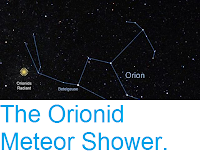Asteroid A/2017 U1 passed by the Earth at a distance of about 24 085 000
km (62.7 times the average distance between the Earth and the Moon, or 20% of the distance between the Earth and the Sun), slightly after 5.50 pm
GMT on Saturday 14 October 2017. The size of this object is unknown, bit it is not thought to be large enough to present a significant threat to the Earth.
Image of A/2017 U1 taken on 26 October 2017 with the Pearl Telescope at the Tenagra Observatory in Arizona The
asteroid is the point in the
centre of the picture, indicated by the two red lines. The longer lines are stars, their elongation
being caused by the telescope tracking the asteroid over the length of
the exposure, in this case 25 exposures, each of 150 seconds. Gianluca Masi/Virtual Telescope/Michael Schwartz/Tenagra Observatory.
A/2017 U1 was discovered on 18 October 2017 (four days after its closest approach to the Earth) by the University of Hawaii's PANSTARRS
telescope on Mount Haleakala on Maui. The designation A/2017 U1 indicates that it is an asteroid (A), and that it was the first object of its kind discovered in the second half of October 2017 (period 2017 U). This is not the usual way of naming asteroids, due to the unusual circumstances surrounding the discovery of A/2017 U1. The object was originally designated C/2017 U1, in the belief that it was a comet, as it us following a hyperbolic path through the Solar System, however multiple observations of the object have revealed no trace of a coma (tail), suggesting that it should in fact be classified as an asteroid.
The calculated trajectory of A/2017 U1. The Sky Live 3D Solar System Simulator.
A/2017 U1 is believed to be following a hyperbolic trajectory through the Solar System, at an angle of 122° to the plane of the Solar System. As such it has been classified as a Hyperbolic Asteroid, the first body ever given such a designation.The asteroid is believed to have passed the Sun at a distance of 0.16 AU (16% of the distance between the Earth and the Sun, or about 23 935 000 km), and to have been 553 AU from the Sun in 1917.
Since A/2017 U1 has no coma it must have either formed within the snow line of a star (i.e. close enough to a star that ice particles could not form on it in the absence of an atmosphere, which in our Solar System means inside the orbit of Jupiter), or to have visited the Inner Solar System enough times to have completely lost its ice. Since it is on a hyperbolic trajectory, which typically occurs to comets when they are knocked out of deep-space orbits by encounters with other bodies, but cannot have originated in deep space, there is considerable speculation among the astronomical community that this body may have originated in another star system.
See also...
Follow Sciency Thoughts on
Facebook.








